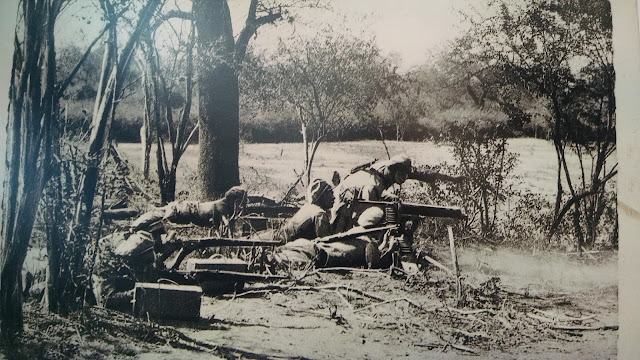We're actually in Brazil now, I'm very behind in my posts! Here's where I left off.
The Chaco makes up 60% of Paraguay's territory, but only 3% of the population. Last post I covered the nature of the Chaco; today I'll discuss the people. The human story of the Chaco is really three stories: the indigenous tribes, the Chaco War, and settlement by the Mennonites. Sources: museums in Filadelfia and Asunción.
The indigenous peoples of the Chaco didn't have much contact with the outside world until the 20th century. Pre-contact, the tribes were semi-nomadic hunter-gatherers, living in grass huts. They used plant fibers for weaving, and since the Chaco doesn't have rocks(!) they used the native hard woods for their tools and weapon points.
The Chaco War in the 1930s was devastating; both sides treated the indigenous peoples as enemy spies and killed them.
The Chaco War (1932-35) started as a territory dispute between Bolivia and Paraguay. Both countries had historical claims to the land, but never resolved the borders because for years the Chaco was viewed as dangerous, impenetrable wilderness. This changed when international oil companies speculated that the Chaco had a rich oil field, and both sides scrambled to stake a claim. Over 100,000 soldiers died in the conflict, a significant blow to the small populations at the time. There were more casualties from thirst or exposure in the harsh climate than actual fighting. Paraguay won and was awarded most of the disputed land. We saw the ruins of Ft Toledo at the Proyecto Taguá.
As a side note, after the war, some of the uncontacted tribes started scavenging metal from the wreckage to make tools.
Enter the Mennonites (well, right before the war, in 1928- all these chronologies overlap). The Mennonites of Paraguay shared with us their heroic story of escaping persecution and settling the Chaco. The Mennonites are German-speaking religious refugees, originally from Switzerland and Germany. In the 1500s they split from the Protestant church for their radical beliefs: believer's baptism (no baptizing babies) living simply, and pacifism. They've moved from country to country ever since to escape persecution, but have been able to maintain their unique culture.
The Mennonites of Paraguay had (mostly) been living in the Russian Empire, where they'd been invited to live by Catherine the Great and granted exemption from military service. Later emperors gradually imposed more and more restrictions on them, but they were able to live peacefully until the Bolshevik Revolution. As relatively wealthy landowners, they were considered class enemies. They were attacked, many sent to labor camps, and not allowed to leave the country. Some groups were finally allowed to emigrate in the late 1920s and early 1930s, but even leaving wasn't certain. They'd board trains to Latvia, but some of the trains were turned back and sent to labor camps instead. Here's a group giving thanks at their arrival in Riga:
Why Paraguay? Land was cheap in the Chaco since no one wanted it, and both Bolivia and Paraguay promised to respect their beliefs.
Arriving in the Chaco was a shock. After traveling for weeks by ship and by wagon, their promised land was hot, the soil sandy, the plants spikey, and the water salty. Whole families died from tropical diseases. Then in the 30s, the Chaco war started. During the war they were treated as neutral (and helped protect some of the native peoples from the fighting, which helped form the basis of a positive relationship that exists to this day). They persevered through all these hardships, and gradually built their communities from scratch to become an oasis of order and productivity. The colonies are now Paraguay's largest producers of beef and dairy products. The Mennonite Cooperative owns all land and runs all services (and many stores) and all members lease their land and pay taxes to the Co-op.
We stayed in Filadelfia, the largest town of the Fernheim colony. An orderly, modest suburban town of wide dirt roads. Filadelphia is so important in the Chaco that in the 90s the Paraguayan government declared them to be the capital of their provence (which has necessitated some changes to the way the Co-op administers land and services). All the locals we met were very open to explain their history and values: hard work, simplicity, and thrift. We visited several farms and Co-op businesses, including the supermarket, post office, and a saddle factory.
There are two points of friction with the colonies today. The Mennonites are actively turning wilderness into pasture: they preserve a significant percentage of the land as wild, but some conservation groups claim that it's not enough or that the regulations are ignored. The colonies are also attracting more and more ethnic Paraguayans. The Mennonites live separately to preserve their culture, so non-Mennonites live in their own barrios and intermarriage is unusual.
Filadelfia is unique, compelling, and certainly off the beaten path. Well worth the effort to visit.
-Peter








Peter! Thanks for the post card. Chaco looks like some epic country for rally! You are correct, Dakar moved to S America in 2009. They run various routes between Argentina and Chile. Safe travels!
ReplyDeleteThanks! I forgot to update my postcard list after I sent that one, so you'll be getting another at some point- whoops!
ReplyDeleteThis comment has been removed by the author.
ReplyDeleteThis comment has been removed by the author.
ReplyDelete